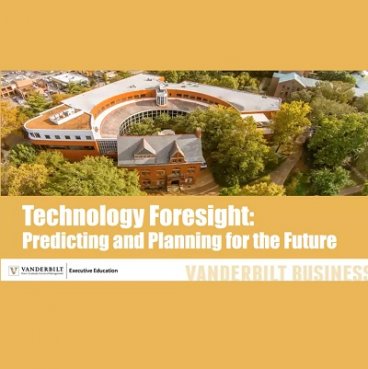
Tim Mack
Submitted by Tim Mack on
As part of its executive education webinar series on workforce planning in the “next normal,” Vanderbilt University hosted a Zoom lecture June 23 on “Technology Foresight: Predicting and Planning for the Future” led by Professor Andy Van Schaack of the School of Engineering Management. The goal was to present futures techniques needed to redesign workforces for a new business landscape.
Van Schaack dealt with four methods of technology forecasting—Monitoring, Expert Opinion (Delphi), Trend Extrapolation, and Scenario Development—that the user could apply across an industry area of interest. While attendees had no audio or video capability during the webinar, they were able to participate in a range of interactive Zoom techniques, including polls. Participants suggested what industries they wanted the session to cover (e.g., health care, education, manufacturing, and transportation) and responded to the question of what technology would change the world the most by 2045. Suggestions included virtual reality, artificial intelligence, synthetic biology, CRISPR, blockchain, and relaunchable rockets. Van Schaack observed that AI would help create all the other technologies.
• Monitoring. Technology development monitoring includes surveying social and economic impacts, basic scientific findings behind technology proposals, laboratory feasibility, and operational and commercial practicality. These technology trends can be discovered from work in R&D labs, industry conferences (such as the Tesla battery conference), competitions (X Prize); academic journals (Google Scholar), and tech-oriented magazines (MIT Technology Review).
• Delphi. The Expert Opinion/Delphi discussion described several approaches that aim to avoid the “wisdom of crowds” fallacy as well as the predictable irrationality of dominating experts, unresolvable disputes, and unwillingness to listen. The method consists of multiple convergence rounds (four here) of surveys, but factors such as moderator choosing experts and drafting the question still remain problematic. One solution has been moving beyond panels of academics to a full range of stakeholders from industry and impacted communities. Van Schaack suggested that the Delphi Method would be good way to get expert opinion when there is a lack of historical data, as in the case of COVID-19’s impacts on the hospitality industry.
• Trend Extrapolation. Forecasting trends can be addressed by charting growth curves, inverse curves (e.g., the replacement of propeller with jet propulsion), or substitution curves (e.g., replacing horses with cars). Plus there are underlying factors, such as overlapping S-curves such as transport by canal, then rail, then road, then air.
• Scenario Development. The steps for building scenarios are analyzing relevant factors (especially external forces), scenario creation using the four-cell matrix (least to most, worst to best); identification of SWOT (strengths, weaknesses, opportunities, threats) and TOWS (mapping strengths to opportunities to identify your most obvious natural priorities); and producing action plans with specific actionable recommendations for each different scenario. Attendees rated this method the most likely to be used by their own organization.
Impact and uncertainty were factors here (likely/dangerous), but those scenarios initially picked drive subsequent response plans, where variables include qualitative versus quantitative focus and the robustness of the outcomes (agreement among participants and within the four-way factor analysis). Of course the goal is to identify where trends are going versus where they have been.
The implication here is that forecasters who have had good results previously may not have productive results going forward. One solution response is a methodical process with enough transparency to allow third-party analysis, plus the presentation of results in a clear and understandable fashion.
This requires disclosure to the audience of the sources of data utilized, the analytical methods involved, and the assumptions made. This sort of transparency will have an impact on how third parties respond to the forecasts. Van Schaack closed comparing forecasting to chess—you can learn the rules fairly quickly, but mastery takes a lifetime to develop.
During the webinar’s discussion period, Van Schaack noted that there are more than a hundred approaches to forecasting, but the four described were the most common for technology forecasting. Another he said could be added is modeling to understand the mechanisms underlying what’s happening. New methods are likely to be iterations of these four methods but using technology to do it better, such as AI to do the modeling using massive data, he said.
This one-hour presentation was designed for a business audience, but Van Schaack noted that his college-age students at Vanderbilt did seem to be applying the lessons learned in his class to lifelong decision making. The existence of this course in a school of engineering seems to be a sign of the acceptance of foresight as a useful tool for a range of audiences—another “Next Normal.”
[Watch “Technology Foresight: Predicting and Planning for the Future”]
Timothy C. Mack is former president of the World Future Society (2004-2014) and managing principal of AAI Foresight Inc. He may be contacted at tcmack333@gmail.com.

